Panoramic glazing – luxury windows for luxury homes. Panoramic windows
What are the good and bad things about full-wall windows? How to clean panoramic windows on high floors of apartment buildings? What to look for when choosing them? How to solve the problems of heating and cleaning windows? What to do with excess light? In this article I will try to answer a number of the most frequently asked questions.
Pros and cons
- What are the pros and cons of panoramic windows?
Advantages
- The floor-to-ceiling window provides great natural light even in cloudy weather. As you know, sunlight is the least tiring for the eyes, which is not surprising: our vision has evolved, adapting specifically to its spectrum;
- It visually increases the size of the room - both due to and due to the fact that part of the border outlining the visible space disappears. The interiors of the apartments are completely transformed;
- The window allows you to enjoy the beautiful landscape of the surrounding area - views of the sea, mountains or the city at night.
![]()
Flaws
I’ll be frank: there are much more problems associated with panoramic windows than arguments in their favor. For me, at one time the advantages outweighed them, but after several years I am no longer so sure of the correctness of my choice.
Judge for yourself:
- Larger window sizes mean higher prices. At one time, panoramic glazing with an area of 26 square meters in the attic cost me, at the minimum prices in Crimea, approximately 65 thousand rubles. Since then, prices have roughly doubled. As the unforgettable Ostap Suleimanovich Bender said: “Kisa, we cannot avoid reparations;
- IN apartment building installing a panoramic window will require demolishing the cabinet under the window sill and rotating the heating radiator or replacing it with a low heating device. Doing this without approval is illegal. Obtaining permission to change the configuration of the utility network and the facade of the house is a long, tedious undertaking with questionable results;

The cabinet is to be demolished, the radiator is moved to another wall or changed to a low one.
Hint: if you are not going to sell the apartment in the foreseeable future and draw up a new registration certificate, a panoramic window can be installed between the room and the balcony with a continuous fence. This, strictly speaking, is also illegal, but the changes will not be visible from the street. Panoramic glazing on the balcony does not require approval either, provided that your house is not an architectural monument.
- A typical double-glazed window has noticeably lower resistance to heat transfer compared to a solid wall. Therefore, heat loss through the enclosing structures will increase. Your apartment will become colder, and if you have a heat meter or autonomous heating your heat costs will increase;
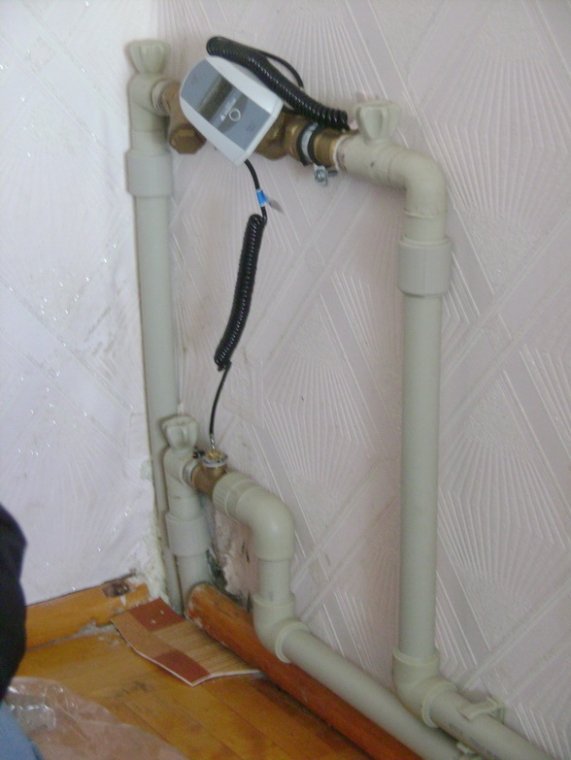
There are configurations of double-glazed windows that are comparable to main walls in terms of the degree of thermal insulation. In particular, a triple-glazed unit with two energy-saving glasses and filled with argon in terms of heat transfer resistance corresponds to 70 centimeters of brick. However, such a window will approximately double the already considerable costs.
- With panoramic glazing, it will be a problem to create thermal curtain. Yes, this problem is being solved, but again at a considerable cost. ABOUT possible solutions I'll mention it a little later;
- In sunny weather, a room with large glazing will be very hot. The only exception is the north side of the house. The southern side is illuminated at an oblique angle throughout the day; in the east and west, the rising or setting sun illuminates the room for only a few hours a day, but almost at a right angle;
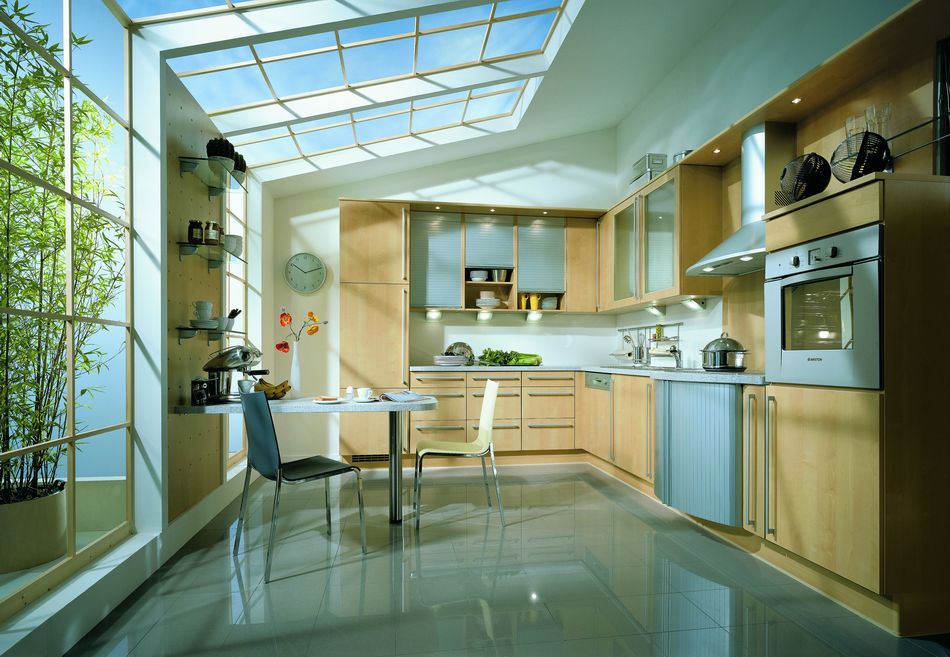
I testify: my attic with glass gables is oriented strictly from east to west, and about 6 hours a day the air conditioner works at maximum cooling load.
- Finally, one cannot discount the indiscreet glances of passers-by. Panoramic windows in a private house, a ground floor apartment or on any floor with a nearby house opposite will make you feel like a fish in an aquarium. To protect against indiscreet glances, you will have to keep curtains or blinds closed at all times. But then, excuse me, why do we need large windows at all?

Installing a panoramic window and then keeping it tightly curtained is a strange idea, don’t you think?
Frame material
- Which panoramic window frames are better - aluminum, plastic or wood??
With a limited budget for the project - unconditionally plastic. Arguments? Please.
Due to the high thermal conductivity of the metal, the inexpensive aluminum frame is a continuous cold bridge. It will not only facilitate the outflow of heat from the room, but will also become covered with frost in frosty weather.
Sliding panoramic warm windows made of aluminum exist in nature, but cost about the same as a small private jet due to the complex profile structure: thermal insulation is provided by several polyamide inserts.
In terms of thermal insulation qualities, they are still inferior to PVC casement windows.

In terms of thermal insulation qualities, wood is not inferior to, and sometimes even superior to, PVC profiles. Moreover, modern glued frames undergo pressing and preservation, making their geometry and dimensions absolutely stable under any fluctuations in temperature and humidity.
What's the catch?
In price. Even an inexpensive frame made of soft pine or fir will cost the buyer at least one and a half times more than a plastic one. Replacement of cheap ones coniferous species for noble wood (ash or oak) will increase costs by another 2-3 times.
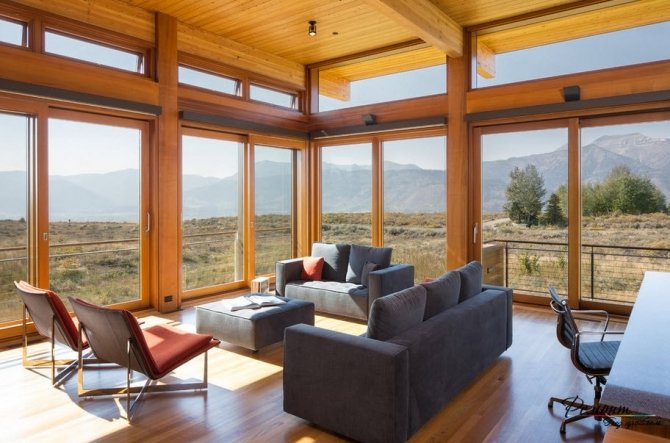
What about plastic? How good is he?
- The service life of PVC frames is estimated to be at least 50 years;
- The material tolerates any fluctuations in humidity, is resistant to fungus and can be washed with any cleaning agents;
- If necessary, PVC is painted in any color (including throughout the entire volume of plastic) or covered with a decorative film that very reliably imitates the texture of wood.

Brands
Profile
- Which profile systems should you prefer when choosing windows??
If a price difference of 15 - 20% is not critical for you, it is better to choose profile systems from famous German manufacturers - KBE or Rehau. From my own experience: they differ from inexpensive domestic and Chinese-made profiles in that they are more rigid. This quality comes in handy when large area windows and, accordingly, significant wind loads.

Cheaper profiles usually have a thinner metal liner. At one time I chose the most inexpensive Chinese Hautec profile; in windy weather, a slight vibration of the frames is noticeable, which is not surprising given the size of each window 5x2.6 meters.
Accessories
- Is it possible to save money on accessories??
No, no and no. Wear or ill-conceived mechanics of low-quality fittings will mean loose closure of the sashes or constant jamming of the handles in intermediate positions.
Here, without options, you should give preference to quality products famous manufacturers. I chose Siegenia - Aubi hardware; except her, good reviews on Russian market the brands Winkhaus, Maco and Roto deserved.

- What to look for when selecting this or that fittings?
Here are instructions based on my own experience in using plastic windows:
- Hinged sashes must have a transom mode (when the sash tilts towards itself). It is desirable that there be a microventilation mode (fixing the sash when tilted in an intermediate position by turning the handle). The transom mode allows you to ventilate the room in the rain without fear of puddles on the floor, and microventilation will provide a limited influx fresh air in the cold;
- The sash must be fixed in the closed position not only by the central lock, but also by pressure rollers at the bottom and top. It is the pressure when turning the handle that will ensure tightness. If the door is secured only by the lock tongue, the inevitable deformation of the profile will eventually leave gaps at the top and bottom of the opening.
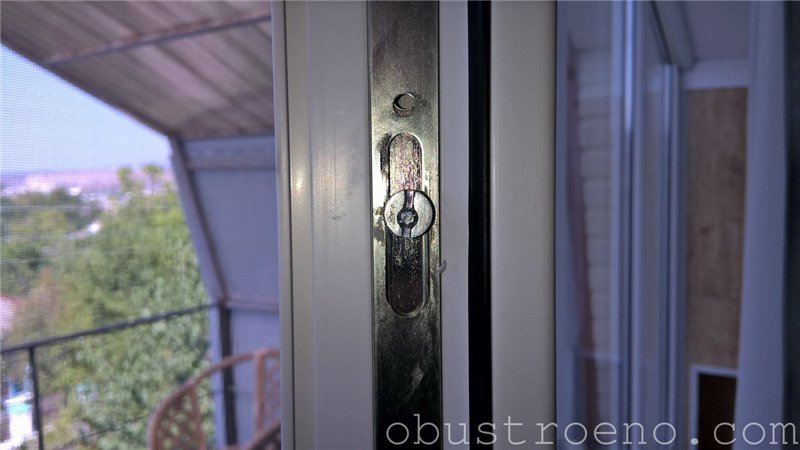
Double-glazed window
- How to reduce heat loss through large windows?
Losses are determined by two factors:
- Convection of the air gap between the glasses. Heat transfer due to convection decreases with an increase in the number of glass unit chambers: in this case, the temperature difference on adjacent glasses decreases, which, in fact, sets convection currents in motion;
Reducing convection losses is facilitated by replacing the air in the double-glazed window with argon. It is more viscous, which helps slow down the movement of convection currents, and has lower thermal conductivity compared to air.

- Infrared radiation. The size of this part of the heat loss is determined by the temperature delta between the street and the room, as well as the permeability of glass in the infrared part of the spectrum. Energy-saving glasses with limited transparency in the infrared spectrum have been developed specifically to reduce losses due to radiant heat.

As I wrote above, the highest degree of thermal protection is provided by a double-glazed window with two energy-saving glasses and argon filling.
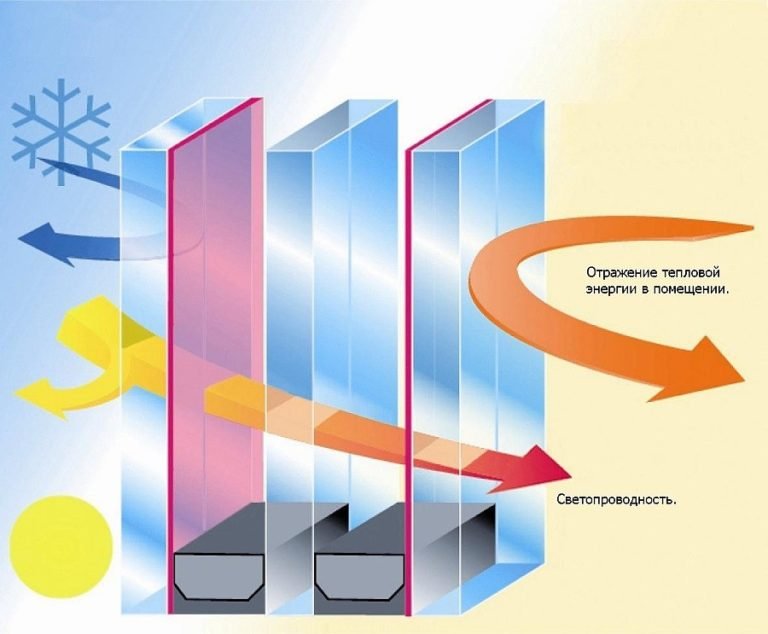
Here is an approximate dependence of the thermal efficiency of a double-glazed window on changes in configuration:
When choosing the attic glazing structure, I preferred budget option, typical for Crimea - a single-chamber double-glazed window with one energy-saving glass and air filling. It showed its high efficiency in winter frosts, which were rare for Sevastopol: at -20 outside, +20 in an area of 60 square meters was supported by one inverter air conditioner with a capacity of 12,000 BTU (4.1 kilowatts in heating mode).

- Is it possible to reduce noise from the street??
Yes. For this purpose, sound-insulating double-glazed windows with glass and spacer frames (gaskets that define the distances between the glasses) of variable thickness are used. The difference in thickness makes it possible to effectively dampen acoustic vibrations in different areas of the sound spectrum.
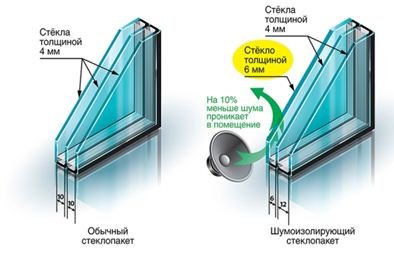
- How to protect yourself from excessively bright sun?
A double-glazed window may include solar control glass with limited permeability in the visible spectrum. By combining solar control and energy-saving glass in one package, you can reduce not only insolation, but also the heating of the room in sunny weather.

Another solution is to stick solar control film on the glass of panoramic windows.
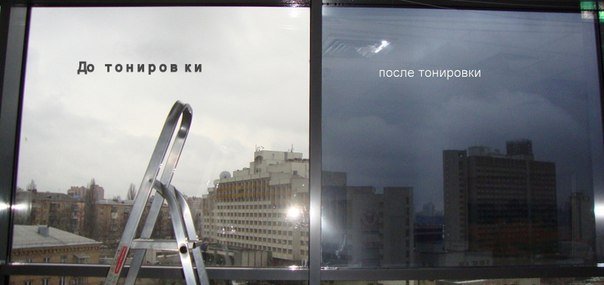
I strongly recommend removing the double-glazed windows to apply it: in this case, there will be no gaps along the edges of the film that are constantly clogged with dirt. In addition, this will eliminate the risk of damaging rubber seal along the perimeter of the sash when cutting the film to size.
How to do this work yourself?
- Use a knife or sharp spatula to pry one of the vertical beads out of the frame;

- Repeat the operation with the remaining glazing beads. Take out the top one last: it will hold the glass unit in the frame until the last moment;
- Place the glass unit on a table or other horizontal surface on top of a piece of fabric;
- Thoroughly wash its inner surface from dirt and dust;
- Cut the film to the size of the glass;
- Remove the liner (backing) from the film;
- Wet the glass and adhesive surface of the film with soapy water;
- Lay the film over the glass;
- Use a dry cloth or plastic card to blot out the soapy water, starting from the center and working outward. The water will completely displace the air bubbles. Don’t be afraid to leave a small amount of water under the film: it will evaporate quickly;
- Install the glass unit into the frame;
- Center it relative to the sash with plastic inserts;
- Press the top bead and hammer it into the frame with a rubber mallet or hammer through a block;

- Repeat the operation with the remaining glazing beads.
If desired, you can also find energy-saving film on sale, which is only slightly inferior to energy-saving glass in terms of thermal insulation properties.
Curtains, roller blinds
- How to protect a room from indiscreet views from outside?
Blinds are attractive because they provide maximum protection not only from prying eyes, but also from light. By the way, aluminum horizontal blinds They protect from the sun better than those made of PVC: vinyl, although thin, still allows some light to pass through.

Fabric roller blinds(roller blinds) - an ideal solution for panoramic windows on the lower floors with moderate illumination from the street. When closed, they retain limited translucency; At the same time, from the street you cannot see what is happening in the house.
I chose traditional blackout curtains - impenetrable to light thick fabric. Their choice was dictated by the complex shape of the attic ceiling and the presence of triangular inserts in the upper part of the window.
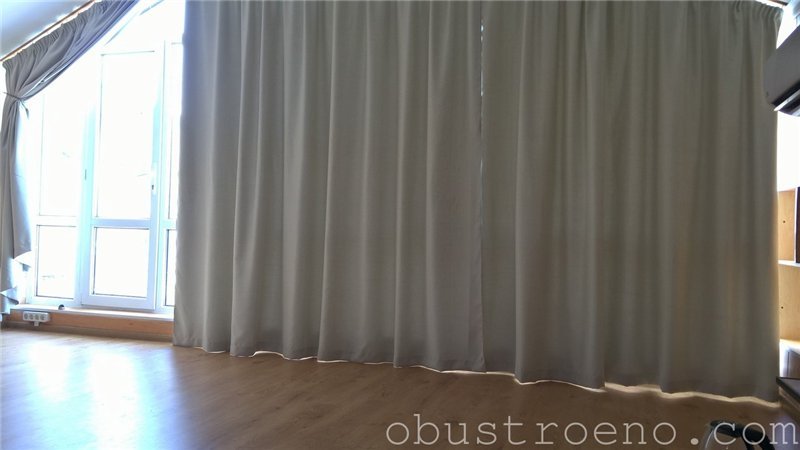
For large window areas and warm climates, it is better to choose fabric that is light on the street side. It will reduce the heating of the room in sunny weather.
Thermal curtain
- What heating radiators can be used to create a thermal curtain in front of a panoramic window?
Here are some of the most popular solutions:
- Low heating radiators for panoramic windows have a height of 200 - 350 millimeters and are mounted on floor brackets;

- A warm baseboard is a type of convector (tubes for coolant with developed fins to increase heat transfer) with a height of no more than 20 centimeters. It is equipped with a decorative screen (steel, brass or aluminum) and its appearance really differs little from a high baseboard;
- Heating of the glazing can also be achieved by installing in-floor convectors or fan coil units. They are mounted under a wooden floor or in a screed. The heating devices are covered from above with decorative grilles;

- Finally, a thermal curtain in front of the window is created by all types of heated floors - water, film and cable.
Care
- What and how to clean a panoramic window?
Washing from the inside is quite traditional: first - with water and any detergent, then with clean water, then with glass cleaner. The last stage is wiping with a dry cloth that does not lose lint.
For obvious reasons, cleaning windows from the outside on the upper floors is much more difficult.
The simplest solution is to use a window squeegee. To wash blind sashes, you may need a mop up to one and a half meters long. In addition, when washing, I strongly recommend using insurance - a mounting belt with a chain, attached, for example, to a heating riser.

Panoramic glazing has entered people's lives rapidly. Why? Yes, because the cost of housing on the market directly depends on its location, living space, type of building, layout and, of course, the view from the window. Breathtaking landscape from the pano window frame glazing in metropolitan areas and large cities, dictates the price. Keeping up with world fashion trends is not just a matter of good taste. First of all, this speaks of prestige. Now let's talk more about all of the above.
Style and beauty
The generally accepted name “Panoramic glazing” applies to windows whose size occupies the entire area of the wall. There won’t necessarily be one such wall, because country houses can reveal the best scenery from all sides. Thus, the most original building of the last century was a glass house, designed by the American Philip Johnson. Now this house is a museum, which indicates the high appreciation of this decision. The high-tech style dominates in architecture; designers want unimaginable, unexpected solutions.
Providing housing with maximum illumination and the most advantageous view from the window, visually increasing its area - this is the purpose of the presented type of glazing. The panorama will look advantageous both in high-rise buildings and in a country cottage. Of course, the first option is more interesting, because... at the height of several floors, the entire landscape will be located at your very feet. Beauty and scale panoramic glazing They give confidence, calm and talk about freedom of action.
What to consider?
When designing a house, the architect must initially consider the possibility of implementing panoramic glazing. The inter-glass fillings should be as narrow as possible in combination with wide light openings. The limitation is the load-bearing capacity of the posts and beams. Removing the batteries is mandatory. But it is uncomfortable to live without heat in the cold season. Embedding radiators into the floor immediately eliminates a number of problems: visibility is not impaired, there is no condensation in the double-glazed window. Parts not intended for opening are built into the supporting structures of the structure.

Frameless glazing of the loggia
Advantages
It is possible to install a single glass without breaks, but this design does not allow ventilation of the room and causes some hassle in maintaining it from the outside. It is worth paying attention to the rigidity of the profile, its thinness and thermal conductivity. Maximum rigidity will ensure a long service life of the structure. If desired, you can install automatic opening/closing drives. Control is carried out from a remote control, which is also controlled by wind and rain sensors. Systematic access control switching will allow you to control access to the building. Multifunctional glass in double-glazed windows retains heat in the room in winter and helps reduce air conditioning costs in summer period. Sound insulation will be at the same level thanks to the same high-quality glass. If the windows face sunny side, the entire interior will be subject to burnout. Therefore, the choice of glass occupies the first place in importance, not only because of the colors with the possibility of applying drawings and other upgrades. The transmission of electromagnetic waves is important here.

Frameless glazing of the gazebo
Flaws
For some, this may seem like a drawback, but a number of rules are necessary to maintain panoramic glazing at a level. The high coefficient of light reflection of glass will not eliminate heat gain when exposed to sunlight. You will have to spend money on good system air conditioning. “Fixed” windows require expenses for a ventilation system, because... There will be no other way to get air into the room. Controlling with a remote control will also not be cheap. The weight of the structure may not be easy to handle, because the current legislation did not take this “know-how” into account. Only the developer, at his own peril and risk, will take responsibility for the installation of panoramic glazing.
Ventilated parts reduce the level of comfort and pleasure from such glazing. In winter, expensive thermal convectors and panel radiators are used to avoid fogging and freezing of glass. One of the main disadvantages is full visibility inside the room from the outside. The solution would be tinted glass or glass with mirror image. And again, these are additional costs. Not every architect will take on a project with panoramic glazing. There are very few of these specialists, and the services of such people are more expensive.

Frameless glazing of the terrace
Conclusion:
You need to weigh the positive and negative aspects of panoramic glazing before starting construction or immediately before purchasing a home;
-
be morally prepared for “closeness” with the outside world and its inhabitants;
-
lovers of cleanliness should also think about maintaining glass in proper condition;
-
If you have acrophobia, it is undesirable to buy housing with floor-to-ceiling windows, and even at a great height.
From the article you will learn:
Currently, the option of glazing a window opening with a panoramic type of structure is in demand not only among owners of luxury apartments, but also among owners of spacious private houses. Housing with a large area, being glazed with panoramic windows, acquires a number of advantages that owners of small-sized dwellings can only dream of.
And although wood annually wins a certain percentage of the market from plastic, this artificial material still remains the most popular material for such light-transmitting structures.
In this article we will look at the advantages and disadvantages of panoramic glazing, describe its existing types and features of choice, both for an apartment and for a country house.
What is a panoramic window?
The panoramic window is large transparent design, made, in our case, using plastic. It is the dimensions of a panoramic window that differs from the conventional solution used in glazing the vast majority of buildings.
The phrase “large size” does not simply mean an increase in the area of light-transmitting structures to non-standard sizes, but the maximum possible increase - from floor to ceiling. Often panoramic windows in a house or apartment completely replace external wall. This method of glazing is designed to ensure the maximum level of light entry and make the space of the adjacent room extremely illuminated.
Is it possible to install such wide-format windows in an apartment?
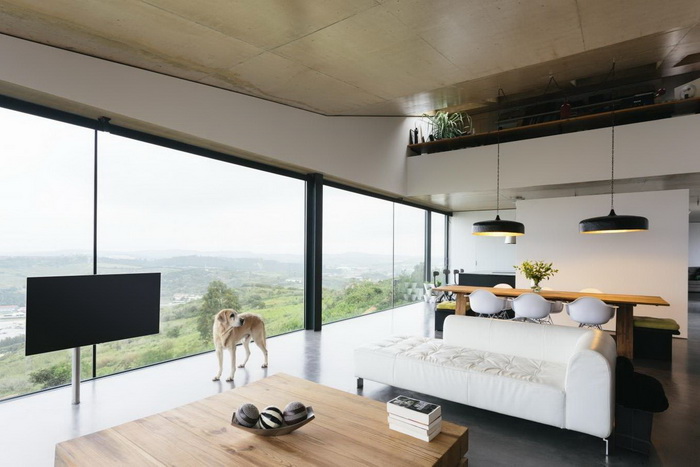
Organization of glazing window openings the panoramic window of an ordinary city apartment cannot do without its redevelopment. After all, to install such wide-format, or as they are also called, French windows, you will need to expand the opening and, accordingly, groove or even demolish a part of the wall that falls into the category of capital ones.
In all cases, redevelopment must be formalized accordingly - there is no way to do without it. Even if it is planned to glaze only the balcony with a window stretching from the floor to the ceiling, without affecting the load-bearing walls, then this action will also require registration, because such, one might say, a significant alteration of the balcony directly affects appearance building, which, after all, is included in the general architectural appearance of the city.
Let's consider the sequence of actions for legally obtaining permission for redevelopment apartment, and therefore for the installation of panoramic windows in it.

Where to start. We obtain permission from the building owner. Most often, its role is played by an architectural bureau at the city mayor’s office, or a special architectural organization authorized to resolve such issues related to the possibility of making minor changes to the appearance of city buildings. At the same time, you need to be mentally prepared that the process of completing all the documents is very long and can last from several weeks to several months. So:
- We request drawings for an apartment from the city's architectural bureau.
- With the received drawings we go to a construction organization capable of developing a drawing of the future large-format window.
- With the original drawings, we go back to the architectural bureau and confirm the possibility of converting the apartment with panoramic glazing.
That's all. In principle, there is nothing complicated in the procedure for obtaining permission to redevelop an apartment, however, before you start completing the paperwork, you need to have large stock in time, a certificate of ownership of the apartment and a small amount in monetary terms (around 10-15 thousand rubles) to resolve all issues.
Read also: What are the types of double-glazed windows for plastic windows?
Of course, there is no 100% guarantee that the resolution from the city’s architectural bureau will be positive (see point 3). An owner who wishes to install a panoramic window in an apartment may be refused for a number of reasons, the main ones being: the fragility of the building’s partitions or its belonging to historical and unique areas of the city (at the discretion of the city’s chief architect).
Types of panoramic glazing
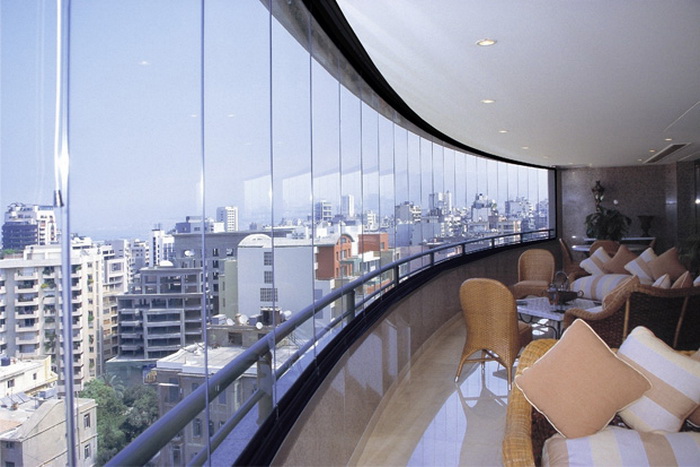
Currently, there are two types of panoramic glazing: with the use of frames running along the contour of the glass, and without their use. Let's take a closer look at the features of each.
Frameless glazing. Belongs to the cold type. Frameless panoramic windows are not able to effectively cope with heat conservation - with their installation, the temperature in the adjacent room will not be much higher than the street temperature. This feature greatly limits the scope of application of such structures. Large windows that do not have a frame (see photo) are mainly used for glazing balconies and loggias, verandas, and various extensions. They protect well from the wind and visually expand the area of the glazed space.
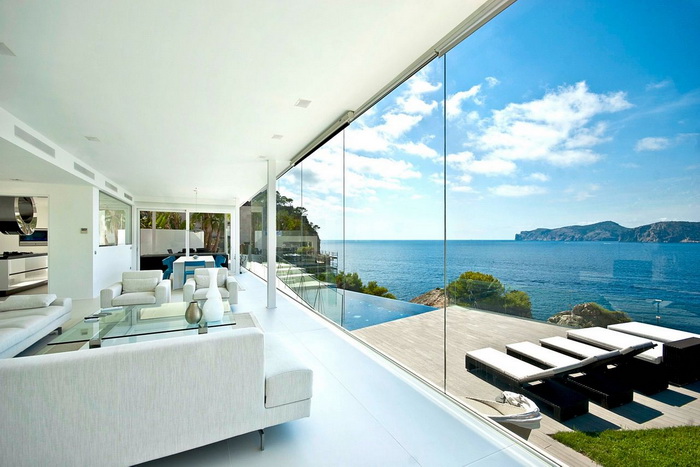
Depending on the thickness of the glass (0.6-1.0 cm), and, therefore, on the weight load created, the height of the transparent structure can reach 4 meters. The glass used in the panoramic window is not standard, usually used in conventional plastic systems, but special - tempered.
A reasonable question: if there is no frame that serves in a regular window, then what is used to hold the glass? The glass is fastened to guide profiles located in the upper and lower parts of the opening. If necessary, by sliding along such profiles, the sash of such a window can work both to open and close.

Frame glazing. The frame used in this type of light-transmitting structures is a profile coated with a layer of polyvinyl chloride (commonly called plastic). Inside, the profile is divided into chambers designed to reduce heat conduction from the room to the street. Due to this function, or more precisely, due to the number of chambers, the profile also provides different levels of heat conservation. In addition to the profile in the design plastic window and is responsible for the degree of heat retention. It can be, depending on the number of cameras, of three types: one-, two- and three-chamber.

The maximum possible heat saving in the adjacent room can be achieved with windows, design feature which involves combining them with a three-chamber double-glazed window. When planning frame glazing, it is necessary to take into account the weight of the future system - with a double-glazed window with three chambers, the weight of such a window measuring “from floor to ceiling” should be no more than 80 kg. The maximum possible dimensions also differ from the frameless version and can be no more than 2.1 m x 0.9 m.
What to consider when choosing

When choosing the optimal panoramic window option, the following factors should be taken into account:
- Dimensions of the light-transmitting structure. Due to weight restrictions (preferably no more than 80 kg per sash), maximum dimensions plastic panoramic window should not exceed 3m x 3.2m.
- Profile. When selecting a frame window, you must choose a model with a reinforced profile. Reinforcement, in other words strengthening, is an integral component of any high-quality window. It is responsible for the ability of large structures to resist weight and inevitably occurring wind loads. You can additionally read about the advantages of having reinforcement in a double-glazed window in the article: “.”
- Number of cameras in a double-glazed window. are not able to bear the heavy load created by a double-glazed window with three chambers, and therefore the most the best option from the point of view of the price/retained heat ratio, the installation of a two-chamber option will be.
- Distance between glasses. If the distance between the glass panels is large, then the window will not effectively cope with heat retention. Therefore, it is recommended to opt for products whose inter-glass space values are within 1-1.5 cm. It is worth noting that double-glazed windows with an even smaller distance between the glasses are susceptible to high risk destruction, since due to sharp fluctuations in temperature and atmospheric pressure, the glasses can “play”, thereby creating a threat of contact with each other, and therefore their damage.
- Glass type. The choice of one or the other depends on the location of the windows. If they face the sunny side, it is recommended to equip panoramic structures with either mirrored or tinted glass. The canvases of the latter, depending on their properties, come in several colors. When the home windows are oriented in directions with short solar activity, it will be sufficient for the owners to install a panoramic solution with ordinary glass.
Read also: How to insulate a plastic window for the winter. Instructions for action
Disadvantages of panoramic glazing

The high cost of panoramic windows does not mean that such designs should a priori be free of disadvantages. There are certain disadvantages. How significant they are - each potential buyer decides for himself.
Let's list them:
Significant heat loss through the glass unit. Large format glass is not in the best possible way cope with heat retention. Therefore, in order to reduce the heat loss that inevitably occurs with such a large glazing area, you should opt for designs that include either a double-glazed unit with conventional glass, or a single one, but equipped with special energy-saving glass. The second option is used, as a rule, in cases where it is necessary to reduce the load on the fitting mechanisms. To further reduce thermal conductivity, you can order. At the same time, unfortunately, it will not be possible to check whether gas is actually pumped into the inter-chamber space of the product on your own.
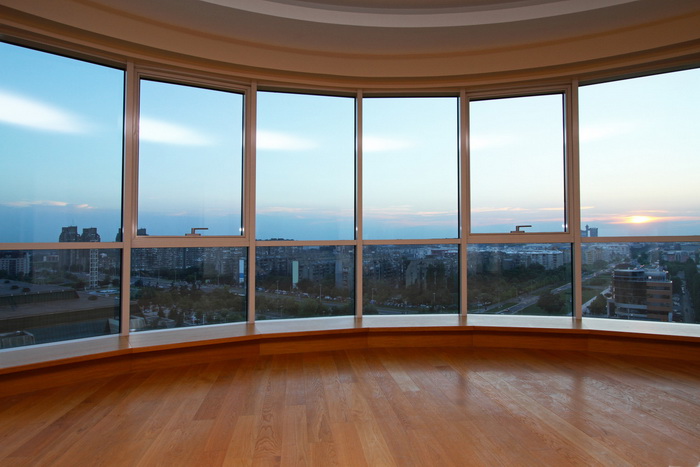
Small heat loss due to window profile. Three-chamber window profile It makes sense to choose only if you plan to install a panoramic plastic window with a large glass unit area. If the panoramic glazing is “assembled” from windows small sizes, then to effectively retain heat in the adjacent room, you should definitely choose plastic window models in which the space in the profile is divided into 4 or 5 chambers.

Reduced level of sound insulation. A similar problem with a large plastic window in most cases is relevant for homeowners located in urban areas. The noise of cars passing under the windows, barking dogs and loud speech are not the most welcome “guests” in cozy home. To effectively resist sounds coming from the street, in some cases, a single-chamber double-glazed window is not enough - homeowners have to resort to installing additional protection in the form of double-glazed windows. Such a move inevitably promises an increase in the mass of the entire structure.

The appearance of ice on window glass. A large area of double-glazed windows may not always heat up evenly. IN winter time year, this fact can cause certain problems for owners of homes glazed with panoramic windows, the basis of which is plastic. Running streams of water, flowing down, difficult visibility from the window due to icing of the glass - these are just the main troubles associated with uneven heating of the double-glazed window. To prevent this from happening in winter, in a glazed room you should consider the possibility of installing a thermal curtain that allows you to more efficiently warm the air, working in parallel with heating radiators.
Currently, there is a constant increase in the popularity of panoramic glazing. This technology is beginning to be used everywhere, in buildings for a wide variety of purposes. Panoramic windows can be seen in private houses, apartments (regardless of the number of floors apartment building), in public buildings (shopping and business centers), in office premises. What is the reason for the popularity of panoramic glazing?
A panoramic window is not only decorative element interior This design also carries practical meaning. Thanks to panoramic glazing, the following advantages can be achieved:
- Visual expansion of the room space. A panoramic window that occupies most or the entire wall gives the illusion of increasing the area of the room. The use of panoramic glazing in small spaces is especially beneficial.
- Increasing illumination. Thanks to the panoramic windows, the room will be almost as bright as the outside. This, in turn, will provide an opportunity to abandon the use of artificial lighting in daytime days, which will entail a reduction in electricity costs. But we will look in more detail at the advantages and disadvantages of panoramic glazing towards the end of the article.
Rice. 1. An example of the design of panoramic windows.
Panoramic windows are a design that includes several double-glazed windows. They occupy most of the area or the entire wall of the room. Panoramic windows, as the name suggests, were created primarily to provide an opportunity to observe the view of the surrounding area from the room. The price of this design depends on the following factors:
- Window area
- Selecting a double-glazed window (single-chamber or double-chamber, etc.)
- The choice of fittings (in particular, the cost is influenced by the material from which the components of the panoramic window are made)
- Selection profile system
- The complexity of installing the structure (depending on the types of panoramic windows, information about which is indicated at the end of the article)
Panoramic windows for office and home

Rice. 2. Private house with panoramic glazing.

Rice. 3. Apartment with panoramic windows.
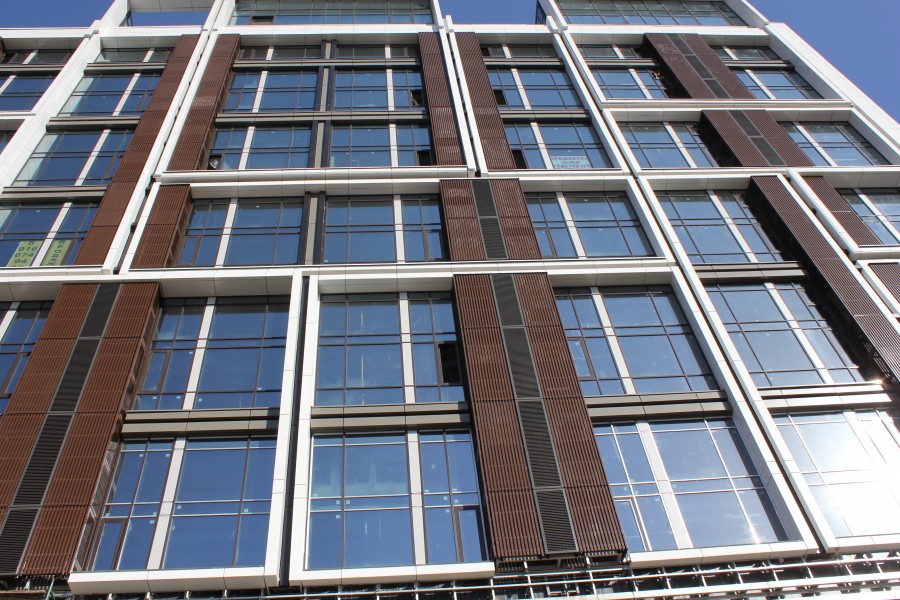
Rice. 4. High-rise building with panoramic glazing.
It should be noted that panoramic glazing is by no means the prerogative of only high-rise buildings. Large windows can also be installed in private homes. Naturally, the most the right time To implement this technology, this is the beginning of building design. This option will allow you to use large panoramic windows in the design of your house as efficiently and safely as possible. Yes, it is possible to replace windows standard size followed by dismantling the wall. But at the same time, it will be necessary to carry out a significant reconstruction of most of the house and redistribute the load in a way that will allow the building not to lose its strength and stability (since most or the entire wall will be replaced with a panoramic window). But these are special cases.
Things are much simpler with the use of this technology in modern high-rise buildings. Therefore, now it is very rare to find office space, in which there is no panoramic glazing. Large windows not only increase the brightness of the space, but also create the illusion of its expansion, which, in turn, allows employees to be more productive and efficient during working hours.
Panoramic glazing of the cottage and veranda
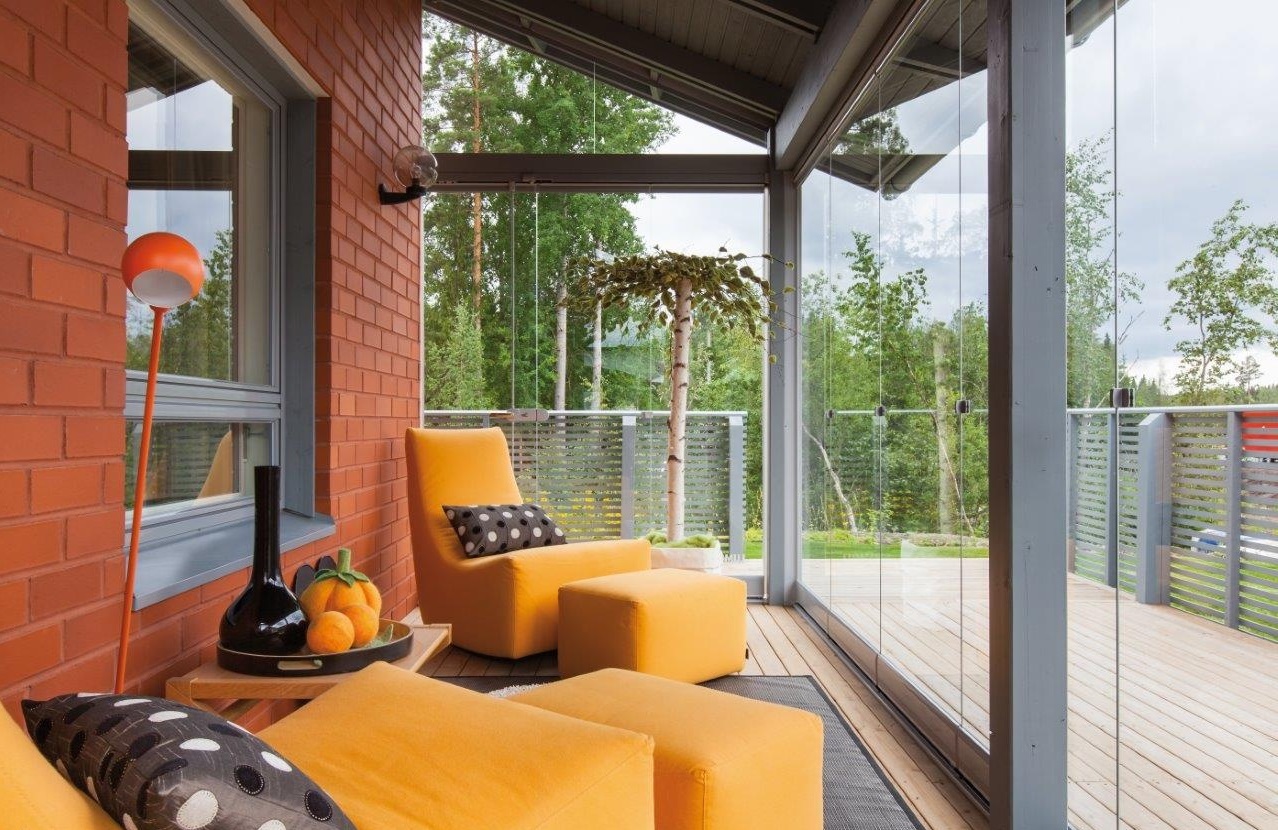
Rice. 5. Panoramic glazing of the veranda.

Rice. 6. Panoramic windows in the cottage.
Panoramic glazing can also be used not only in buildings located in the city area, but also in cottages located outside it. It should be noted that large windows can be installed not only in the walls, but also in the ceiling of the attic, which gives more opportunities for interior design. This solution will be an excellent addition to the children's room on the top floor of the cottage. But it also has a significant drawback. The beauty of the night starry sky will be replaced by scorching straight lines sun rays during the day (in warm seasons). And, despite the increased thermal insulation properties and the presence of sun protection film, the window will not be able to completely protect the floor and the rest of the room from sunlight. Therefore, it is advisable to equip panoramic windows on the ceiling with special roller blinds.
In addition to walls and ceilings, panoramic glazing can also be used on balconies and loggias. You isolate the room from noise and dust, while maintaining a view of the surrounding area.
Panoramic glazing of the veranda is one of the simplest procedures. This room, as a rule, does not bear excessive load on the structural elements, so there is no need to strengthen them. You just need to select double-glazed windows that have the necessary strength characteristics. The veranda with panoramic glazing will be a wonderful place to relax.
Panoramic glazing of restaurants and cafes
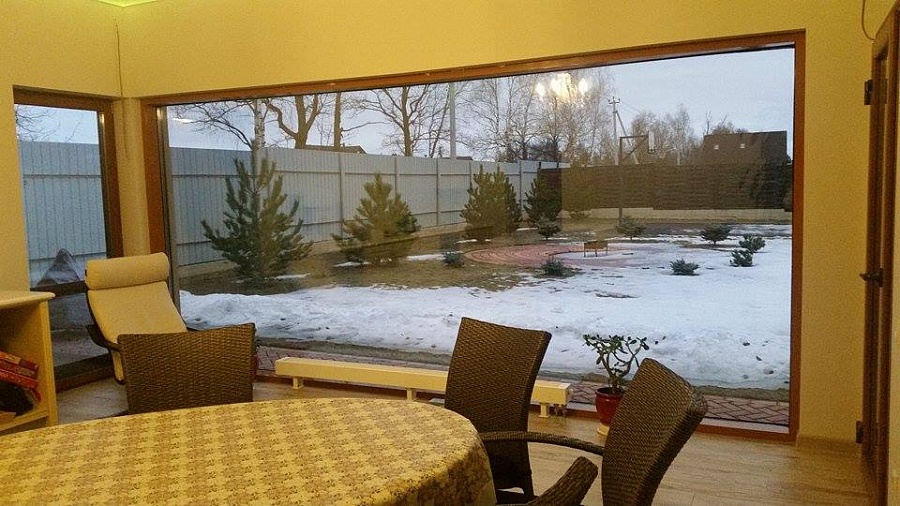
Rice. 7. Restaurant with panoramic windows.

Rice. 8. Cafe with panoramic glazing.
Good cuisine, competent and efficient staff - these factors are certainly important for increasing the popularity and success of a restaurant or cafe. But far from the least role in this regard is played by good design interior Visitors should not only like the food and service. They should be comfortable. Therefore, when designing the interior, it is vital to create the right atmosphere of the establishment. And, if the room is located on the upper floors of a high-rise building, or in a tourist area, then the most favorable solution would be to provide cafe visitors with a view of the best part of the city, which always surpasses the view of blank walls (no matter how beautifully decorated they are).
It should be noted that for panoramic glazing of restaurants and cafes, double-glazed windows with high strength, thermal insulation and sound insulation should be used. Visitors should have a wonderful view, but without the penetration of street noise from vehicle traffic.
Also important detail is that carrying out the replacement standard windows for panoramic ones requires coordination with the relevant authorities and inspection of the premises by specialists in the construction industry. This will allow for the correct and safe use of this technology without possible negative consequences.
Technical requirements for panoramic windows
For a panoramic window, it is better to choose double-glazed windows made of tempered glass. In addition to increased strength characteristics, this material is coated with a special protective film, which, if the integrity of the glass structure is damaged, holds the fragments together, preventing them from crumbling.
You cannot select double-glazed windows larger than 3 * 3.2 m and with a width of space between the glasses exceeding 2.5 cm. The large internal space of a double-glazed window with a sharp temperature difference can provoke compression or expansion of the air insulating layer. This may subsequently lead to depressurization of the window and disruption of the integrity of its structure (gaps will appear in the seal, etc.).
It is necessary to choose a sufficiently strong aluminum profile that can withstand the load from a heavy double-glazed window. The durability of the entire structure directly depends on the correct choice. The following requirements are imposed on the profiles:
- It must be possible to install a wide glass unit (more than 5 cm)
- Possibility of profile reinforcement (to increase strength)
- Elevated thermal insulation characteristics(to reduce heat transfer through the profile)
Advantages of panoramic windows
It should be noted that the use of panoramic glazing is advisable only if there is an excellent view of the surrounding area. And if the panorama that opens from the windows is only depressing or, at best, does not evoke any emotions, then it is better to leave everything as it is. But if you still want to make panoramic glazing of your premises, regardless of the presence or absence of an attractive view of the surrounding area, carefully read the following paragraphs of this article. Panoramic windows have a number of irrefutable advantages, which we will look at in more detail below.
Maximum room illumination
Naturally, what bigger window, the brighter the room will be. And since with panoramic glazing, as a rule, one of the walls is completely replaced with double-glazed windows, the illumination of the room will increase several times. In the office this feature will allow you to do without artificial lighting during the daytime, which, in turn, will lead to energy savings. The same applies to higher educational institutions, and private residential buildings. It should be noted that natural light in moderation has a beneficial effect on health.
Visually increases the area of the room
Panoramic glazing creates the illusion of expanded space. This feature is perfect for rooms with a small area (living rooms, verandas, loggias, balconies, kitchens, offices, etc.). Visually expanded space can increase efficiency and, accordingly, productivity. Thanks to the visually increased area, the oppressive feeling from walls that are too close will disappear. Panoramic glazing will be an excellent alternative for visual expansion space, if the possibility of direct expansion of the room area is not available.
Increases visibility from the room
With panoramic glazing, the viewing degree can increase to 1800 (if the entire wall has been replaced with double-glazed windows). This makes it possible:
- Monitor the work of your employees for those in charge of the office department
- Get a great view of the surrounding area (in low-rise buildings)
- Opportunity to observe the panorama of the entire city (in high-rise buildings)
The increased visibility, in addition to the practical component, also has an aesthetic value. It allows you to complement the visual design of the interior of the room, making it more attractive and respectable.
Cons of panoramic windows
As you can see, panoramic glazing is not only beautiful, but also practical. Thanks to the advantages described above, this technology is rapidly gaining popularity in all countries of the world. But near the panoramic windows. Unfortunately, there are several significant drawbacks that can overshadow all the previously described positive characteristics. Of course, most of these negative phenomena can only manifest themselves if the rules and recommendations are not followed during the selection and installation of a panoramic window. Next, we will consider in detail all the possible disadvantages of panoramic windows.
Heat loss

Rice. 9. Infrared image showing heat loss through panoramic windows.
Despite the fact that every year the design of double-glazed windows is improved and the heat-saving characteristics of windows are constantly increasing, at the moment windows, unfortunately, cannot compete with walls in terms of heat transfer resistance. Moreover, panoramic windows. Since they sometimes occupy the area of the entire wall, they can significantly reduce the degree of thermal insulation of the room. Therefore, the use of panoramic glazing is impractical in extremely cold latitudes and is more applicable in countries with milder or hotter climates. Depending on temperature regime you should select a double-glazed window with the optimal number of chambers.
Poor sound insulation

Rice. 10. Window soundproofing diagram.
As is the case with thermal insulation, windows currently cannot compare with walls in terms of sound insulation. Yes, there are examples of double-glazed windows with increased noise reduction. But with panoramic glazing, this figure decreases in direct proportion to the size of the window. Therefore, if you decide to use this technology in the interior design of your premises, keep in mind that the background noise will inevitably increase. But, if the home is located on the upper floors of a high-rise building, then this factor should not be of particular concern to you.
Icing of glass in winter

Rice. 11. Icing of glass.
This problem can become a real “scourge” for homeowners with panoramic windows. It usually occurs in two cases:
- Insufficient power of the floor convector. This device creates a “thermal curtain” - upward flows warm air, which passes through inner surface windows and prevents the formation of ice when there is a large temperature difference.
- Violation of the integrity of the glass unit or profile structure and subsequent depressurization of the window. Deformation of structural elements due to incorrect selection of a double-glazed window or profile creates the opportunity for cold outside air to leak into the protective space between the glasses. This provokes the formation of ice or condensation.
Difficulty in cleaning a panoramic window

Rice. 12. An industrial climber cleans panoramic windows.
If you have huge panoramic windows, cleaning them can be a real challenge. This applies primarily to the outside. Windows. The inside can be washed without any problems. Cleaning the outside of a window requires, at a minimum, a squeegee with a very long handle (depending on the width of the windows) and can be very risky. Therefore, in most cases, owners of apartment buildings with panoramic glazing turn to specialized companies that provide (extremely expensive) services for cleaning windows from the outside using industrial climbers. The cost of this service, in addition to workers, in some cases includes the rental of a special lift.
Low privacy of interior space

Rice. 13. Panoramic windows without protective tinted film reduce the privacy of the room.
This drawback comes into force, as a rule, in cases where panoramic glazing is installed on the first floors. And if double-glazed windows without a special tinted coating were used, which protects the room from observation from the outside.
Yes, if you prefer to keep yours privacy secretly from prying eyes, then panoramic windows made of ordinary glass will not suit you. In this case, it is recommended to use tinted windows for glazing. They will reduce to zero the possibility of seeing everything happening indoors from the street. At the same time, you will see everything that is happening outside.
Restrictions on furnishing the premises
Panoramic glazing usually takes up an entire wall. This may be an advantage, but in terms of furnishing the room it is a significant drawback. You will have three walls at your disposal, which you can use to install and install hanging cabinets, shelves, and arrange tables, sofas and armchairs. If the room in which panoramic glazing was installed has a small area, then you can forget about placing a large amount of furniture in it. But, if you decide to install panoramic windows, then, most likely, you took this fact into account.
The problem of vandalism
This problem is acutely felt, as a rule, by residents of the first two or three floors of apartment buildings and cottages. It is solved by using so-called “armored” double-glazed windows (windows that are extremely resistant to impact loads). But this option is very expensive. Therefore, for panoramic glazing it is recommended to use double-glazed windows with special protective coating in the form of a film. If intruders break a window, it will prevent the fragments from scattering throughout the room and keep them in place. You can also use tempered glass, which when broken will shatter into soft, tiny shards.
Basic elements of a panoramic window
So, you have weighed all the advantages and disadvantages, and decided for yourself that you want to produce panoramic glazing. Moreover, you want to do it correctly so that the window serves you faithfully and properly for many years. So how to choose the right components to install panoramic windows most effectively?
First of all, you should not rely only on yourself in this matter. A more preferable option would be to consult with an experienced specialist who will inspect the room and tell you which elements of the panoramic window will be most suitable in this case.
Profile systems

Rice. 14. Metal-plastic profile.
The profile system, which is the basis for the entire window structure, must have increased rigidity and strength. In most cases, metal-plastic is used as the material for the manufacture of the profile system. This material, unlike wood, is not subject to deformation under prolonged exposure high humidity or dryness due to elevated temperature, resistant to mechanical damage, easy to clean, does not require regular painting or coating protective layer varnish, etc. Aluminum is most often used as a metal in the manufacture of profiles.
Functional double glazing
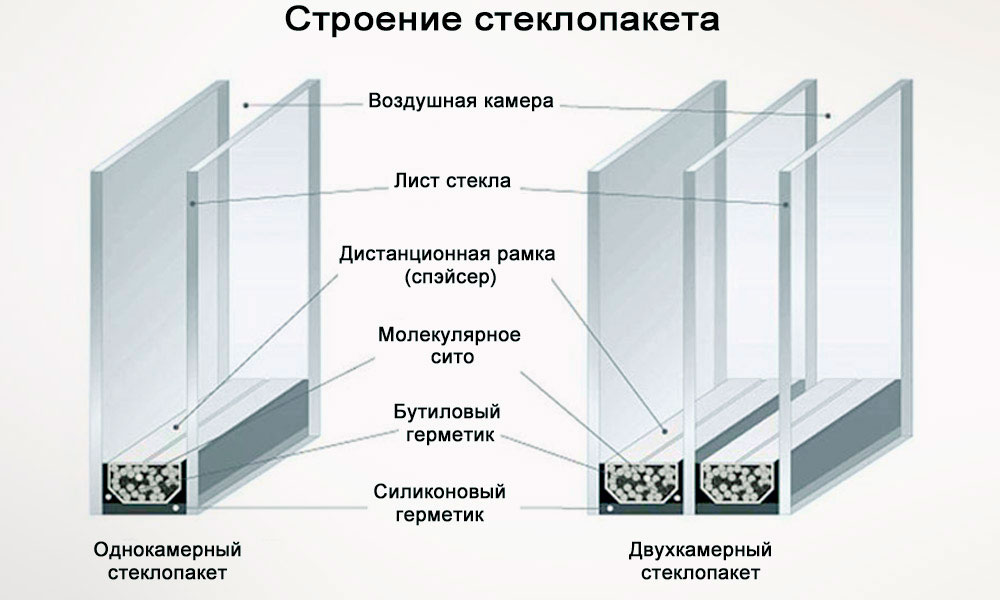
Rice. 15. Structure of a double-glazed window.
Since panoramic glazing can significantly increase the degree of heat loss in a given room, it is recommended to choose heat-insulating double-glazed windows. Depending on the average annual temperature, these can be single-chamber or double-glazed windows (the latter are recommended for use in relatively cold latitudes). An inert gas acts as a filler for the chambers. Most often this is argon. Also, to increase thermal insulation, it is possible to coat the outside of the window with a protective layer of vinyl film or spray metal oxides.
Window fittings

Rice. 16. Accessories.
Even if you have chosen the right double-glazed windows, chosen the optimal metal-plastic profiles, done everything necessary calculations– low-quality fittings can negate all the work done and turn the operation of a panoramic window into torture. Therefore, as with the selection of previously described components, when choosing accessories, consult with specialists in the industry.
Important! High-quality fittings are not made of plastic. All components (hinges, handles, fasteners) must be made only of metal. It is metal fittings that ensure maximum functionality of all window systems (burglary protection, ventilation system, blocker for erroneous opening of sashes, etc.).
Types of panoramic windows
Finally, before you finally make a choice in favor of panoramic glazing, it remains to decide on the preferred and most optimal type of panoramic windows for your room. There are only three of them:
- Classic panoramic windows
- Bay panoramic windows
- Corner panoramic windows
In the last three paragraphs of this article, we will analyze in detail all the advantages and relative disadvantages of these types of windows and find out in which cases it is more preferable to use one or another type. But, as in the other cases described above, when choosing, it is recommended to consult professionals.
Classic panoramic windows
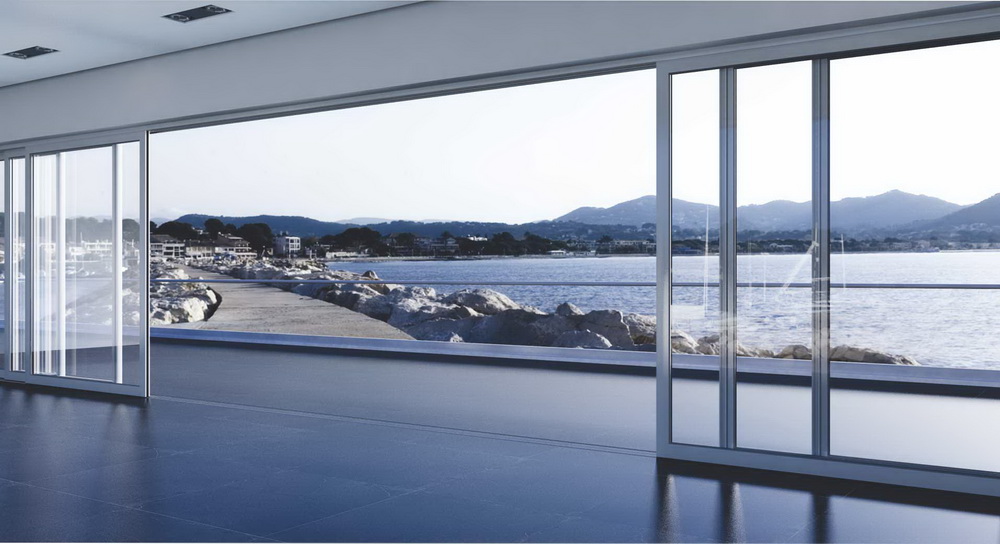
Rice. 17. Panoramic window.
This type of window is the most common in modern architecture. Such glazing consists of panoramic windows covering the entire wall, from floor to ceiling, which are installed strictly in one straight line. Benefits of this type are:
- Ease of installation (relative to the other two types of panoramic glazing)
- Easy to clean. Classic panoramic windows located in a straight line are much easier to clean from the outside on your own than the other two types.
- This type of window is suitable for installation in most buildings with a standard layout.
Bay panoramic windows
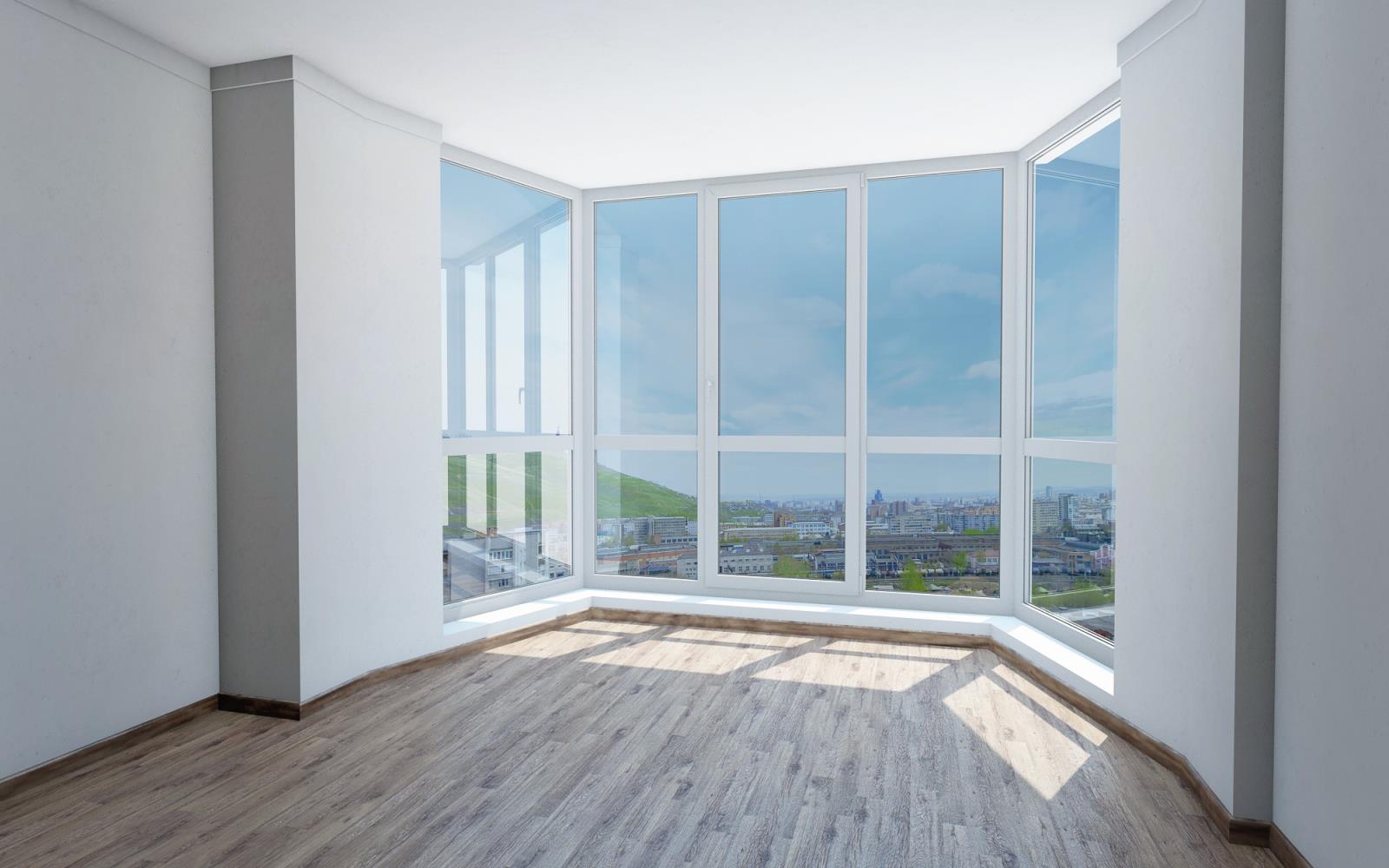

More rare species panoramic glazing. As the name suggests, this method is used for glazing bay windows (a room with a semicircular protrusion on the outside). With this type of panoramic glazing, double-glazed windows are installed at a certain angle, the magnitude of which depends on the radius of the semicircle and the distance between the boundaries of the bay window. Among the significant disadvantages of this method, one can highlight the complicated (compared to the other two types of glazing) process of cleaning the outside of the windows and installing all structural elements.
Corner panoramic windows
Corner panoramic glazing can increase the viewing angle to 2700 (which is impossible when using classic and bay panoramic windows). This type of glazing, in terms of complexity of installation and cleaning, is somewhere between the two options described above.
There are three types of corner panoramic glazing based on the principle of composition:
- Transparent corner. The double-glazed windows are closely connected to each other. The seam between them is sealed using transparent sealant. The use of reinforced profile systems is required.
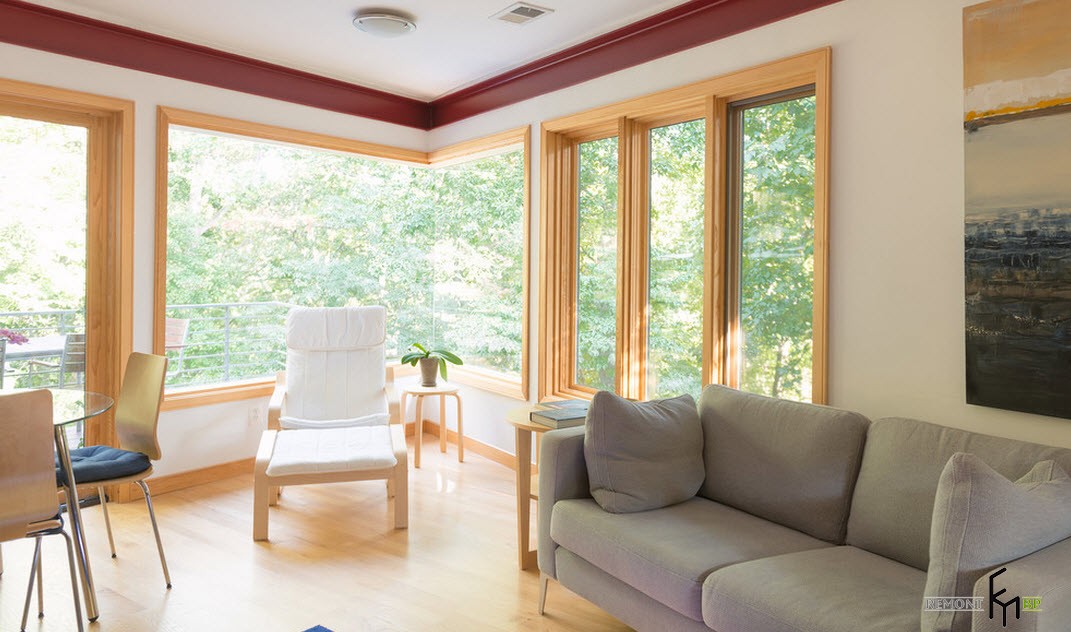
- The window frames are joined at the corner. This method does not require the use of special profile systems

- Corner - load-bearing wall or column. The windows are located as close as possible to this structure.
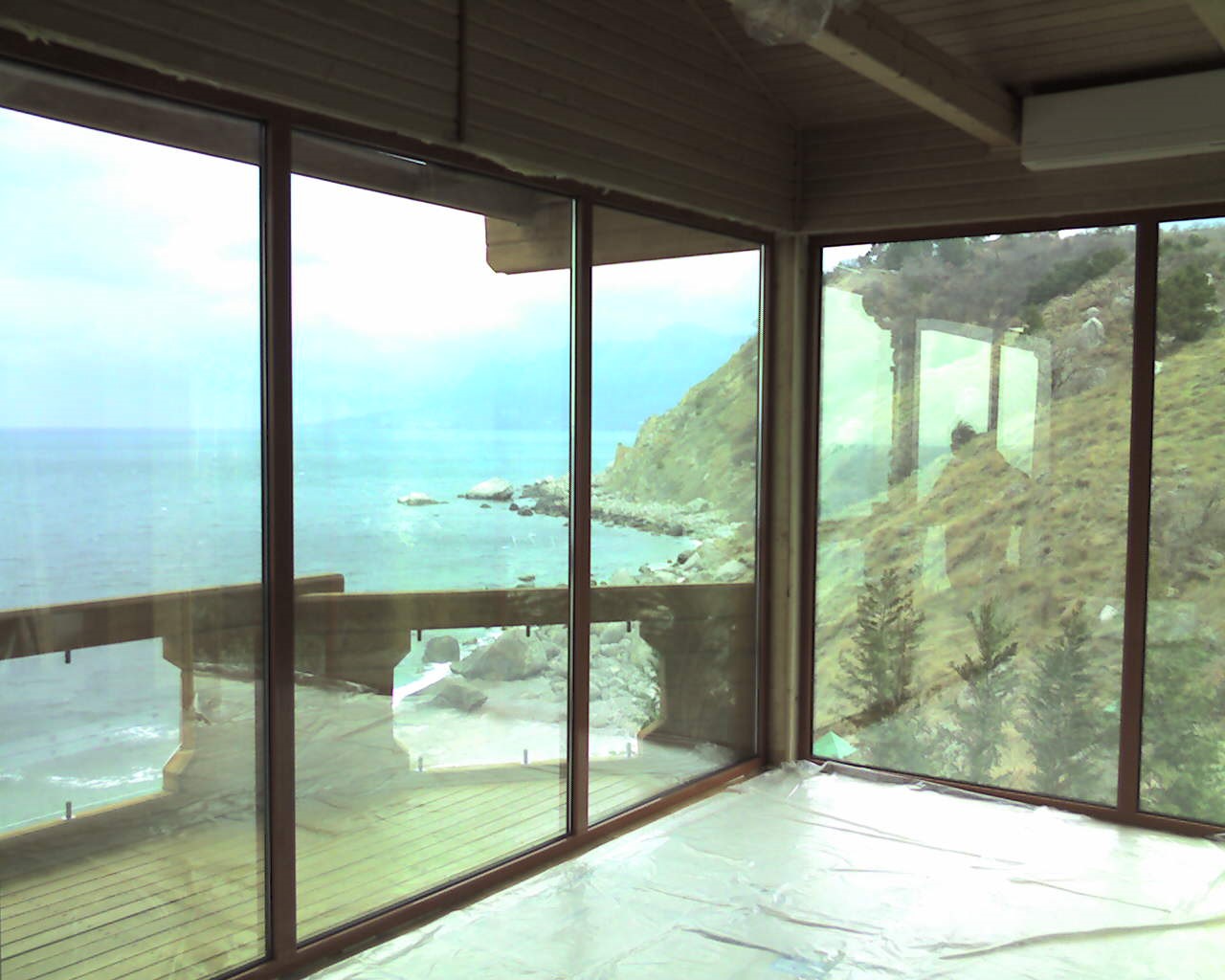
At first it seems that the high price is the main disadvantage of panoramic windows, but after their installation, much more serious problems are revealed that would be correct to prevent or reduce in advance. The cause of the problems is precisely what is so attractive about panoramic glazing - large area translucent wall elements.
Disadvantage 1: Large heat losses through glass
Alas, it is glass that contributes to the most significant heat loss in winter and overheating of rooms in summer. To solve the problem, it is better to use an integrated approach to achieve an effective result:
- When ordering windows to directly reduce heat loss, choose energy-saving or two-chamber ones. Which ones are preferable? Panoteka recommends using heavy double-glazed windows only in extreme cases, exclusively for panoramic windows with small opening sashes; in other cases, it would be more advisable to use a single-chamber double-glazed window with energy-saving glass, so as not to create unnecessary load on the fittings. Filling the internal space with argon will also reduce heat transfer, but the customer, alas, will not be able to verify compliance with this condition of the contract.
- Shutters, a fairly new offering on the Russian market, can additionally reduce direct heat loss. Shutters from artificial material They are attached to the vertical profiles of the window frame and prevent the passage of both hot sunlight and frosty air into the room. They can be opened and completely removable, allowing full visibility to the outside whenever desired.
- Mirror-coated glass perfectly reflects the sun's rays, and similar choice Suitable for south-facing panoramic windows. Tinted glass has a slightly less effect, but they are also used to reflect part of the solar spectrum.
- A thermal curtain in front of the windows will additionally prevent heat exchange between the window and the inside of the room. With a large glazing area, creating a curtain will reduce overall heating costs. More details modern technologies We described thermal curtains in the article on heating.
Disadvantage 2: Heat loss through the window profile
Only panoramic windows made of wood and fiberglass have extremely low heat loss through the profile. Aluminum and PVC windows are significantly inferior to them. When glazing heated rooms aluminum profile You should definitely order warm.
WITH metal-plastic windows It is often advisable to choose a three-chamber profile if the sashes are large. When the relative area of double-glazed windows greatly exceeds the proportion window frames, purchase of four or five-chamber profiles will not provide a significant reduction in heat loss. It makes sense to choose a warmer profile when the panoramic window consists of small sashes.
Disadvantage 3: Increased heating costs
No matter how you reduce heat loss in areas with panoramic windows, they will have to be heated more intensively than similar rooms with ordinary windows. Question efficient heating need to be decided in conjunction with glazing in order to choose the optimal way to heat the rooms.
Disadvantage 4: Insufficient sound insulation
The noise of a metropolis, a nearby highway, stadium or suburban recreation area is naturally undesirable inside the house. A single-chamber double-glazed window with two glasses is not able to dampen sound waves sufficiently. So far, the only effective way for us is to install double-glazed windows with different chamber thicknesses.
However, with panoramic glazing this means a significant increase in the weight of the sashes, rapid wear of the fittings and the need to repair windows more often. The most promising method seems to be the use of acoustic films for windows, but so far we have not found a single offer on the Moscow market, although there is experience in using them at sites in Japan, Europe, and the USA.
Disadvantage 5: Glass icing
Ice on the panoramic windows completely eliminates the possibility of admiring the surrounding view. However, today there are many ways to avoid this by creating a thermal curtain in front of the window. Slot convectors, long-wave infrared heaters, warm baseboards, warm film floors - any of these methods are suitable for combating glass icing.
To create a curtain of warm air, heaters can be mounted in the floor under the window, on the ceiling, walls around windows, in window slopes or window sill. It is advisable to provide for the possibility of autonomous connection of a thermal curtain in order to use this method regardless of the heating mode of the premises.
Disadvantage 6: Energy-saving glass
A bit unexpected, right? We constantly recommend using energy-saving glass for panoramic windows, but it turns out that they have disadvantages that you should know about in advance. By reflecting the sun's rays from the surface, glass with appropriate coating or film creates increased solar radiation in the plane where these rays fall. As a rule, these are walls under the windows and courtyard areas opposite them.
The consequences of exposure to double solar radiation can be as follows:
- burnout (discoloration) of some types of siding;
- wilting and diseases of plants planted under windows;
- warping plastic furniture or artificial lawns;
- strong heating of stone or concrete covering yard and paths.
To avoid such troubles, it is enough to choose a finish that is resistant to solar radiation and plan the design of the yard so that shade-loving plants or plastic products. It is better to use wooden paths or a terrace under such windows.
Disadvantage 7: Difficulty cleaning large windows
Cleaning panoramic windows from the outside is not always easy, and often dangerous if the upper floors of buildings are glazed. Not everyone can afford to hire washers every time. It is better to decide how you will clean large windows before ordering them, since often the number of opening sashes is determined precisely by the need for cleaning, and not just ventilation.
We recommend finding a manufacturer who, before installing double-glazed windows, will immediately coat them with a special photocatalytic composition for. The essence of the action is this: any contaminants decompose under the sun's rays, and at the first rain (or watering from a hose in dry summer) they are simply washed off the glass.
Disadvantage 8: Limitations in furnishing the premises
Availability glass wall in the room limits the possibilities of arranging furniture. You will have to think about how best to admire the landscape through panoramic windows. Of course, tall furniture will have to be placed near other walls, but not every low piece of furniture will be appropriate near a window.
In this case, it is necessary to maintain a balance of objects of different sizes, symmetry and other interior design techniques. Some simpler problems Furnishings are resolved when panoramic glazing begins slightly above the floor. Soon we will devote a special article to the rules for designing rooms with large windows.
Disadvantage 9: Low privacy of the interior space
Replacing blank walls with transparent windows allows you to better view the interior of the house from the outside. Neighbors, passers-by, and guests will be much better informed about your life. Of course, you can close the windows with curtains, but then you will deprive yourself of the opportunity to see the picture outside the window.
During the day, mirrored or tinted glass can protect your privacy. In densely built environments, this is a very good way to hide your personal life. If you don’t want to curtain the windows in the evenings, but still maintain privacy, then choose to install windows under the ceiling or in those parts of the rooms that are not visible from neighboring houses or from the road. Another way is to install decorative screens outside, although such a choice will fragment the view from the window.
Disadvantage 10: Problem of Vandalism
It is usually easier to enter a house through windows than through walls or a strong door, so the danger of breaking into panoramic windows is quite high. Therefore, for panoramic glazing we recommend using the most durable glass: triplex, tempered, armored. You can laminate the outer glass with special armor films.
However, it is much safer to use additionally and, especially, roller shutters. Such protection will quickly scare off vandals. If the house is left unattended for a long time, then it makes sense to install an alarm system and at the same time insure the property.
The presence of shortcomings is not at all a reason to refuse to install panoramic windows, since any operational problem can be solved in several modern ways.
